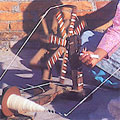The fishermen of Pokhara from the podas and dyolas castes craft their own nets for fishing out of the stems of the stinging nettle (sisnurtica dioicaI: family – urticaceae) found in the high altitudes of the mountains to the north of Pokhara in west Nepal.
These hardy and strong nets are used by the fishermen to catch fish in small ponds and rivers. Though primitive, these highly durable nets have many advantages as they give many years of service since they are easily repairable; they have a wide spreading range when cast and the colour of the net provides easy camouflage against the water – unlike the shining nylon nets these do not frighten the fish.
RAW MATERIAL
The wild stinging nettles used are a special species that and grow into big trees with large leaves. The hill people, mainly the Gurungs, cover their hands with thick wads of cloth when they collect the thick stems of these nettles – if a stinging nettle happens to touch naked skin, the effect is very painful and often it may cause a fever which lasts for 3-4 days. After peeling off the bark the bundles are collected and carried down to the town for sale and further processing. The fishermen buy these bundles and after processing them spin the nets.
PROCESS & TECHNIQUE
The barks of the nettles are boiled in large vessels with some wood-ash till they are well digested. The pulp is then taken to the riverside, where the bark is thoroughly washed with water and pounded heavily.
The remaining soft fibre is then treated with rice-gruel and dried. Next the dried fibres are spun into threads on the spinning wheel (charkha). The threads thus prepared are woven into nets. These knotted circular casting nets measure an average of about 175 cm from top to bottom. It takes 7 to 10 days to make a net.


